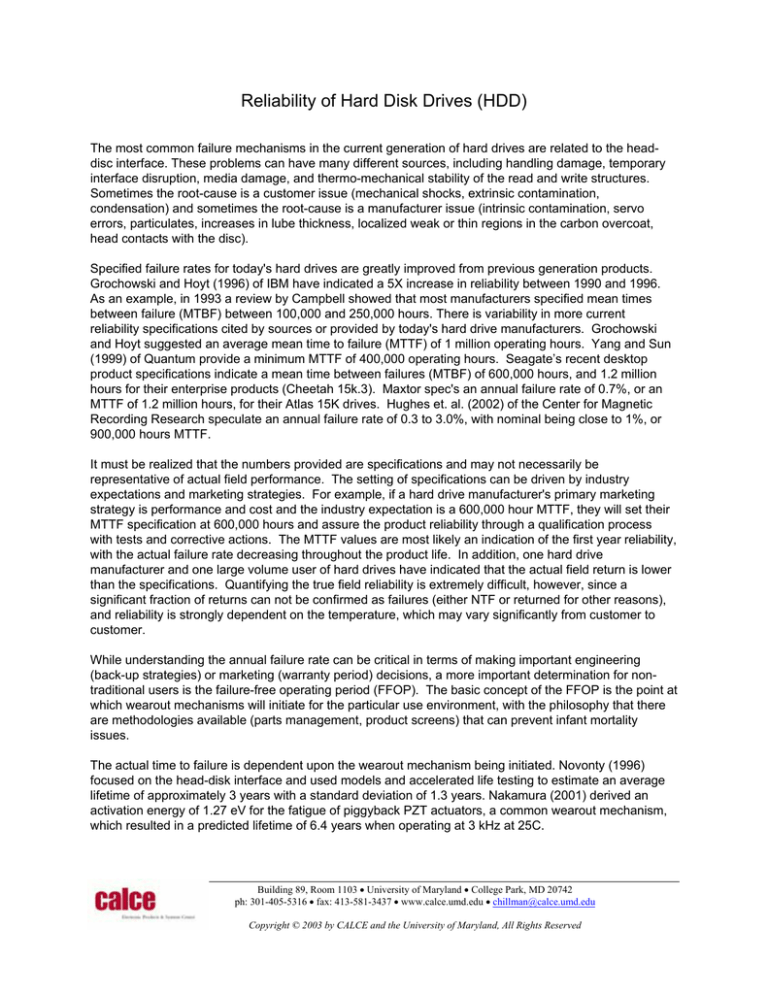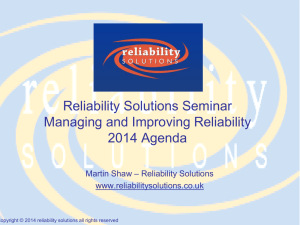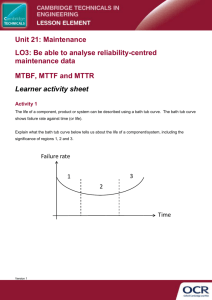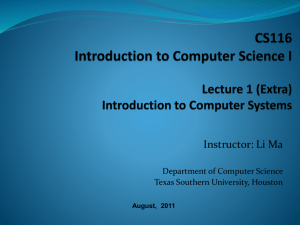Reliability of Hard Disk Drives (HDD)
advertisement

Reliability of Hard Disk Drives (HDD) The most common failure mechanisms in the current generation of hard drives are related to the headdisc interface. These problems can have many different sources, including handling damage, temporary interface disruption, media damage, and thermo-mechanical stability of the read and write structures. Sometimes the root-cause is a customer issue (mechanical shocks, extrinsic contamination, condensation) and sometimes the root-cause is a manufacturer issue (intrinsic contamination, servo errors, particulates, increases in lube thickness, localized weak or thin regions in the carbon overcoat, head contacts with the disc). Specified failure rates for today's hard drives are greatly improved from previous generation products. Grochowski and Hoyt (1996) of IBM have indicated a 5X increase in reliability between 1990 and 1996. As an example, in 1993 a review by Campbell showed that most manufacturers specified mean times between failure (MTBF) between 100,000 and 250,000 hours. There is variability in more current reliability specifications cited by sources or provided by today's hard drive manufacturers. Grochowski and Hoyt suggested an average mean time to failure (MTTF) of 1 million operating hours. Yang and Sun (1999) of Quantum provide a minimum MTTF of 400,000 operating hours. Seagate’s recent desktop product specifications indicate a mean time between failures (MTBF) of 600,000 hours, and 1.2 million hours for their enterprise products (Cheetah 15k.3). Maxtor spec's an annual failure rate of 0.7%, or an MTTF of 1.2 million hours, for their Atlas 15K drives. Hughes et. al. (2002) of the Center for Magnetic Recording Research speculate an annual failure rate of 0.3 to 3.0%, with nominal being close to 1%, or 900,000 hours MTTF. It must be realized that the numbers provided are specifications and may not necessarily be representative of actual field performance. The setting of specifications can be driven by industry expectations and marketing strategies. For example, if a hard drive manufacturer's primary marketing strategy is performance and cost and the industry expectation is a 600,000 hour MTTF, they will set their MTTF specification at 600,000 hours and assure the product reliability through a qualification process with tests and corrective actions. The MTTF values are most likely an indication of the first year reliability, with the actual failure rate decreasing throughout the product life. In addition, one hard drive manufacturer and one large volume user of hard drives have indicated that the actual field return is lower than the specifications. Quantifying the true field reliability is extremely difficult, however, since a significant fraction of returns can not be confirmed as failures (either NTF or returned for other reasons), and reliability is strongly dependent on the temperature, which may vary significantly from customer to customer. While understanding the annual failure rate can be critical in terms of making important engineering (back-up strategies) or marketing (warranty period) decisions, a more important determination for nontraditional users is the failure-free operating period (FFOP). The basic concept of the FFOP is the point at which wearout mechanisms will initiate for the particular use environment, with the philosophy that there are methodologies available (parts management, product screens) that can prevent infant mortality issues. The actual time to failure is dependent upon the wearout mechanism being initiated. Novonty (1996) focused on the head-disk interface and used models and accelerated life testing to estimate an average lifetime of approximately 3 years with a standard deviation of 1.3 years. Nakamura (2001) derived an activation energy of 1.27 eV for the fatigue of piggyback PZT actuators, a common wearout mechanism, which resulted in a predicted lifetime of 6.4 years when operating at 3 kHz at 25C. Building 89, Room 1103 • University of Maryland • College Park, MD 20742 ph: 301-405-5316 • fax: 413-581-3437 • www.calce.umd.edu • chillman@calce.umd.edu Copyright © 2003 by CALCE and the University of Maryland, All Rights Reserved Translating wearout mechanism behavior to an operating lifetime can be problematic, as different designs and different customer environments can result in varying acceleration factors. This can be seen in the variation in service life specified by various hard drive manufacturers. Both Seagate and Quantum have indicated that for the standard operating environment, which is a home or central office, wearout mechanisms do not cause significant failure rates in a typical product life of 5 to 7 years. The Maxtor 5A250J0 is a 3.5 inch drive that is designed for a 5 year service life, but with a specific temperature limit of 55C. For the 2.5 inch Travelstar, IBM states a service life of 3.4 years (30,000 hours) with a more constrained temperature limit of 40C. Other constraints on FFOP include that active operation (Seeking/Writing/Reading) is not continuous and limitations on the number of start/stops of the spindle. Utilization requirements tend to range from 50 to 75% of the time. With drive spindle, each start and stop event, which occurs when the drive is powered down, causes some amount of fatigue to occur at the heads and the spindle motor. For this reason, disk drive manufacturers tend to specify a 50,000 cycle limit for start\stop cycles. As long as the usage environment has fewer than 25 power down events (sleep mode, power off) per day, this limitation would not influence the specified lifetime. Operating a disk drive in a more stressful environment, such as an industrial location with higher temperatures, higher humidity, vibration, and corrosive gases, could result in an increase in the annual failure rate and a decrease in the useful lifetime. The actual effect will be dependent upon the mechanisms that initiate failure and the specific environmental parameters. Future trends in hard drive reliability seem to be towards decreasing failure rates and increasing design lifetimes. This is especially true for potential markets outside the home/office, including automotive, industrial, and avionics, where long-term (>10 years) reliability can be as a significant driver as cost or performance. Penetration in these markets is currently minimal, but with increasing memory requirements, especially with the development of drive/fly-by-wire technology and the increasing use of sensors, significant growth is expected. Disk drive manufacturers have already responded to this potential market by examining failure mechanisms that are initiated at higher temperatures. Nozieres (2000) and Svedberg (2003) have examined failures at high temperatures (>200oC) due to interdiffusion of constituent layers. One area where the disk drive industry is far ahead of the electronics industry is in the area of prognostics. SMART (Self-Monitoring, Analysis, and Reporting Technology) is a capability that allows specific disk drive characteristics are monitored (by the drive, without host software overhead) and compared to “alert levels”. Should an alert level be exceeded, the frequency of monitoring usually increases and a status indicator is written to a register location within the drive. This capability is offered through all the major disk drive manufacturers. SMART can be helpful in predicting and scheduling maintenance to maintain high reliability, though it is unable to detect and respond to assembly-level wearout mechanisms, such as dendritic growth or solder joint fatigue. Building 89, Room 1103 • University of Maryland • College Park, MD 20742 ph: 301-405-5316 • fax: 413-581-3437 • www.calce.umd.edu • chillman@calce.umd.edu Copyright © 2003 by CALCE and the University of Maryland, All Rights Reserved




